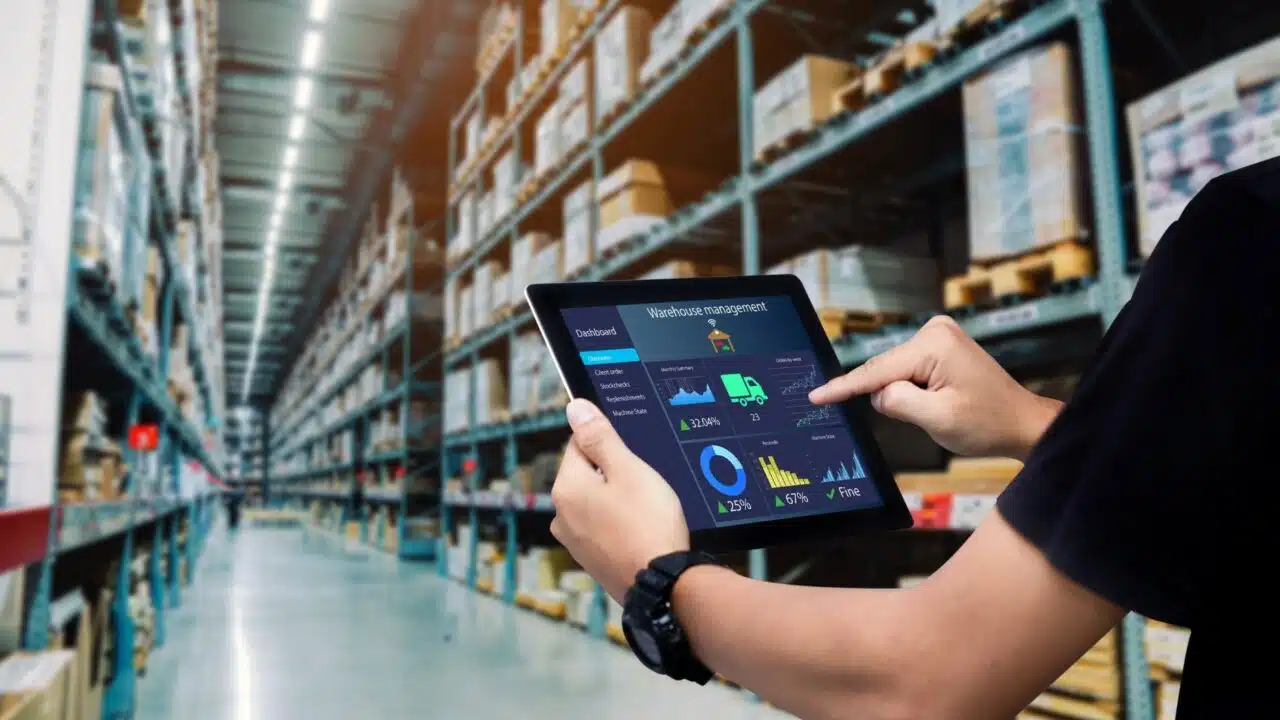Article Summary (TL;DR)
✅ Run a smoother Shopify store: Learn how to efficiently manage your warehouse for a better online business.
✅ Level up your inventory game: This article focuses on mastering warehouse management in the digital age.
✅ Thrive in the digital era: Discover techniques to optimize your Shopify store for success in today’s online marketplace.
Your Shopify store is booming, orders are flooding in, but your warehouse looks like a tornado hit it.
Sound familiar? You’re not alone. In the world of e-commerce, success can quickly turn into a logistical nightmare if you’re not prepared.
Your Shopify store could run more smoothly with a Shopify warehouse management system, which can optimize space and labor hours while saving money.
A Shopify warehouse management system can handle enormous volumes of data pertaining to tracking, order management, storage, and client fulfillment if your company is growing.
But here’s the good news – mastering warehouse management in the digital age isn’t just for the big players anymore. With the right approach, even small Shopify businesses can turn their backroom chaos into a well-oiled machine.
This guide will help you in streamlining your operations, from taming your inventory to shipping orders at lightning speed.
Understanding Shopify Warehouse Management

Let’s start with the basics – what exactly is Shopify warehouse management?
In simple terms, it’s how you keep track of what you’ve got, where it is, and how to get it to your customers fast. It’s like having a super-organized personal assistant for your inventory.
Imagine never overselling an item again, or always knowing exactly what to reorder and when.
That’s the magic of good warehouse management. It’s not just about tidying up your stock room (though that’s a nice bonus). It’s about boosting your profits, keeping your customers happy, and saving your sanity in the process.
Shopify has baked this functionality right into their platform. It’s like they’ve given you the keys to the command center for your business.
You can sync your online store with your physical inventory in real-time, automate tedious tasks, and get a bird’s-eye view of your entire operation.
Think of it as your business’s central nervous system. Every sale, every return, every new product – it all flows through your Shopify warehouse management system.
And when it’s humming along smoothly, you’ll wonder how you ever managed without it.
Leveraging Data & Technology in Shopify Warehouse Management

Let’s talk about supercharging your warehouse game with some serious muscle. Shopify’s got a toolkit that’ll make your life easier and your business smarter.
First up, automation tools. Shopify offers a range of features to take repetitive tasks off your plate. There’s the inventory tracking system that automatically updates stock levels as sales come in.
No more manually adjusting numbers or risking oversells. Then there’s the reorder point setting – tell Shopify when you want to restock, and it’ll give you a heads-up when inventory gets low.
But that’s just the tip of the iceberg. Shopify’s app store is packed with integrations that can streamline your workflow even further.
From barcode scanners for quick stock counts to shipping label printers that work directly with your orders, there’s an app for almost everything.
Key Features to Look for in a Shopify Warehouse Management System

Real-time Tracking & Inventory Management
Updates on inventories in real time are essential to preserving efficiency and accuracy.
You can always know exactly what’s in your warehouse thanks to real-time tracking. It should be game over for manual checks and guessing games
Forecasting & Reporting
The secret to remaining competitive in eCommerce is making decisions based on data. Robust forecasting and reporting capabilities offer insightful information about your business.
You can monitor important metrics like order accuracy, fulfillment speed, and inventory turnover with the use of these services.
Automation of Order Processing & Fulfillment
For eCommerce companies, order processing automation is revolutionary.
Orders can be automatically handled with a Shopify warehouse management system based on pre-established criteria, freeing up your team to concentrate on more important responsibilities.
Returns Administration
Managing returns effectively is essential to preserving client satisfaction. Shopify and a quality warehouse management system work together smoothly to expedite the returns procedure.
Optimization of Shopify Warehouse Logistics
Your Shopify warehouse’s structure and procedures can be greatly improved to cut expenses and increase productivity. Faster processing, cheaper labor, and an all-around more efficient operation are the results of this optimization.
Integration Capabilities
An effective Shopify warehouse management system is built on seamless integrations. The seamless integration of your warehouse management system with other platforms, like Shopify, ERP, and CRM, is essential.
Our Top 5 Shopify Warehouse Management Apps

SkuNexus
SkuNexus is an inventory management app. Its benefits include integrating an inventory management app with an e-commerce platform.
Integrating Shopify with SkuNexus can improve order fulfillment, workflow, and customer experience.
The inventory is automatically updated across platforms and orders can be fulfilled multiple ways.
Pros
- Faster fulfillment, accurate inventory levels, and improved communication with customers about order status can all contribute to a better customer experience.
- SkuNexus can help businesses fulfill more orders and potentially increase sales.
- Streamlined workflows and fewer errors can lead to cost savings in areas like labor, inventory management, and shipping.
Cons
- Its integration can require a bit more effort compared to its counterparts.
ShipHero Inventory & Shipping
ShipHero Inventory & Shipping is a Warehouse Management Software (WMS) designed to help eCommerce brands run their warehouses.
It’s used in multiple owned and operated warehouses throughout North America.
Some of the features of this software include reducing mistakes and mis-picks, reducing warehouse costs, increasing efficiency, and getting end-to-end visibility.
Pros
- ShipHero automates tasks like order picking, packing, and shipping, which can significantly reduce fulfillment errors and lead times. It also provides real-time inventory updates to prevent overselling and mis-picks.
- It offers a variety of automation rules that can help you streamline your warehouse operations. For example, you can create rules to automatically generate pick lists, pack orders, and route shipments.
- Customers consistently praise ShipHero’s customer service team for being responsive and helpful.
Cons
- A bit more expensive compared to its counterparts.
ShipBob
ShipBob is a fulfillment service designed for e-commerce businesses. It offers features like same-day shipping, global fulfillment, and B2B fulfillment.
It integrates with Shopify and other platforms. ShipBob is easy of use, has responsive customer service, and inventory management.
Pros
- Offers same-day shipping, global fulfillment, and B2B fulfillment, which can help businesses meet the needs of their customers.
- Integrates with Shopify and other platforms, which can streamline workflows and save time.
Cons
- Some customers complain that their recent interface changes aren’t very intuitive and can sometimes be counterproductive.
Logiwa
Logiwa offers a cloud-based warehouse management system (WMS) that integrates with Shopify and other sales channels.
It automates tasks like order downloading, inventory syncing, shipment tracking, and order allocation.
This improves efficiency and accuracy. Logiwa can also help prevent overselling and mis-selling by providing real-time inventory data.
Pros
- Improves efficiency and accuracy by automating tasks like order downloading, inventory syncing, shipment tracking, and order allocation.
- Helps prevent overselling and mis-selling by providing real-time inventory data.
Cons
- There’s no documentation or tutorials to refer to.
Craftybase
Craftybase is an inventory and manufacturing app designed for creative entrepreneurs. It helps track materials, recipes, formulas, production runs, and product stock.
It can also calculate the cost of goods sold (COGS) which can help business owners make better decisions, save time, and simplify tax filing. Craftybase integrates with several sales channels and offers a free 14-day trial.
Pros
- Helps track inventory, materials, and production processes, which can save time and improve efficiency.
- Calculates COGS, which can help business owners make better pricing and profitability decisions.
Cons
- It may not be suitable for large businesses with complex manufacturing needs.
Key Benefits of Implementing a Shopify Warehouse Management System

There are many advantages to using a Shopify warehouse management system.
Improved inventory accuracy is revolutionary. Eliminate the need to speculate about supply levels or fret over inconsistencies in your inventory.
Since everything is monitored in real time, your inventory levels are constantly current.
Another significant benefit is faster order fulfillment. Quicker deliveries result in satisfied clients and more business from you.
Orders go from placing to shipment without human intervention when they are automated.
A Shopify warehouse management system lowers labor costs and operating expenses by optimizing processes and minimizing errors.
🗣️ Pro Tip: The key to success is efficiency, and a Shopify warehouse management system makes sure you’re playing the game correctly.
Optimization of Shopify Warehouse Logistics
Your Shopify warehouse’s structure and procedures can be greatly improved to cut expenses and increase productivity.
Numerous Shopify warehouse management systems can assist you in creating an effective structure and streamlining logistical processes.
For instance, the app of your choice can expedite picking times by recommending the ideal location for high-turnover items based on an analysis of your Shopify warehouse data.
Faster processing, cheaper labor, and an all-around more efficient operation are the results of this optimization.
What are the Different Types of Shopify Warehouse Management Systems?
A variety of warehouse management system types exist, such as:
- Standalone Warehouse Management System: Is exclusively concerned with warehouse management tasks.
- Integrated Warehouse Management System: A component of a bigger system with additional business processes included, like an ERP.
- Cloud-based Warehouse Management System: Provides scalability and flexibility, hosted in the cloud.
- On-premise Warehouse Management System: Locally installed on a business’s servers, offering greater control but necessitating more upkeep.
Each type has its own advantages/disadvantages, and the optimal option relies on your unique business requirements.
Data Analytics for Informed Decision-Making

Now, let’s dive into the data side of things. Shopify serves up a feast of analytics that can help you make smarter decisions. The inventory reports show you what’s selling like hotcakes and what’s gathering dust.
You can track your inventory turnover rate, which tells you how quickly you’re selling through your stock.
High turnover? You might need to order more frequently. Low turnover? Time to rethink your product mix or marketing strategy.
In fact, this is so vital, we wrote an entire article dedicated exclusively to inventory management and forecasting demand.
Shopify also offers sales reports broken down by product, giving you insights into seasonal trends or which variants are most popular.
And with the inventory analysis, you can categorize your products based on their value to your business, helping you prioritize your inventory management efforts.
Take note that these tools are only as good as how you utilize them. The key is to regularly review your data, look for patterns, and adjust your strategy accordingly.
It might feel a tad overwhelming at first, but stick with it. Once you get into the groove, you’ll wonder how you ever ran your business without these insights.
Success Stories & Case Studies

Carewell Enhances Operations for Branded Dropshipping
The online marketplace Carewell, which sells supplies for caregivers, needed to enhance vendor communication and order accuracy.
They succeeded in automating fulfillment procedures, improving data flow between vendors, and integrating BigCommerce with ease.
Carewell has experienced enhanced order accuracy, greater customer happiness, and remarkable growth—including $30 million in venture capital funding and exponential revenue growth—since integrating with a Shopify warehouse management system.
Graeter’s Ice Cream Uses Custom Functionality to Automate 100% of Orders
A family-run craft ice cream company called Graeter’s Ice Cream encountered major difficulties managing orders across multiple warehouses.
Due to their system’s inability to handle the increasing demand for eCommerce, inventory data became dispersed and manual fulfillment became problematic.
Graeter’s created a real-time system of record that was fully connected with their Magento platform by using a Shopify warehouse management system.
What was the outcome?
Precise order routing, automated packing instructions, and a significant decrease in errors.
Graeter’s has been able to scale effectively while upholding their commitment to quality because to their streamlined methodology.
The Future of Shopify Warehouse Management Systems

New Developments in Warehouse Management System Technology
Warehouse management is about to change thanks to AI and machine learning. These technologies have the ability to streamline operations, improve inventory levels, and forecast demand.
AI systems, for instance, can estimate future demand by analyzing historical sales data, which can assist you in maintaining the proper stock levels.
Another fascinating development is smart warehousing. This entails managing warehouse operations more effectively by utilizing automation and sophisticated sensors.
Imagine a facility where sensors continuously monitor inventory levels and robots handle picking and packing. This degree of automation can minimize errors and greatly increase production.
Getting Your Company Ready for the Future
It’s critical to adjust to new advancements and technologies. To begin, assess your present systems and pinpoint areas in need of development.
Make an investment in educating your employees to handle new technologies well.
For example, make sure your staff knows how to evaluate insights generated by AI if you intend to use it.
Scalability and constant improvement are essential. Your Shopify warehouse management system ought to develop with your company as it expands.
Examine your procedures often and seek for methods to make them more efficient. Use feedback loops to get team input and make the necessary corrections.
Efficiency and Sustainability
Cutting back on carbon emissions benefits your business as well as the environment. Shopify warehouse management systems that are effective can reduce waste and maximize energy usage.
One way to cut down on time and effort is to optimize your Shopify warehouse procedures and layout for order picking and packing.
Another important topic is using technology to support sustainable activities. Analyze data to find waste reduction opportunities, such as cutting back on surplus inventory or increasing packing effectiveness.
Using sustainable methods improves your brand’s reputation while also saving money.
It’s obvious that embracing innovation and staying ahead of trends will be essential for success as we move to the future.
Final Thoughts
Alright, let’s wrap this up. Mastering Shopify warehouse management isn’t just about keeping your stockroom tidy – it’s about supercharging your entire business.
Remember, implementing a solid Shopify warehouse management system isn’t a luxury – it’s a necessity in today’s fast-paced digital marketplace.
It’s the difference between scrambling to keep up and smoothly scaling your operations.
Whether you’re just starting out or looking to level up an established Shopify store, there’s always room for improvement in how you manage your inventory and fulfill orders.
Embrace the tech, but don’t forget the human element. These tools are powerful, but they’re most effective when paired with your unique business insight and a willingness to adapt.
Keep an eye on those analytics, stay open to new innovations, and never stop looking for ways to streamline your processes.
As e-commerce continues to evolve, so will the challenges and opportunities in warehouse management.
But with the right approach and tools, you’re not just prepared for the future – you’re ready to thrive in it.
Comments
Related Posts
Smart Guide to Import Amazon Data to Google Sheets
Running an Amazon business means juggling dozens of moving parts:…
The ultimate guide to Shopify marketing attribution: what works best for your business?
What you’ll learn Have you ever wondered where your customers…
Top 5 Strategies to Sustainable Shopify Growth: Turning One-Time Buyers into Lifetime Customers
What you’ll learn As a Shopify seller, you’re constantly looking…








Leave a Reply